I've made a few marmalade recipes over the years. So far this Calamondin Orange Marmalade is one of my favorites.
It's neck and neck between the Calamondin Orange Marmalade and the Meyer Lemon Marmalade I made last year.
Last year I spotted this cute little orange plant growing in a hanging basket at Lowes. I was intrigued by this little orange tree. I had never heard of a calamondin orange before. So I, of course, bought one.
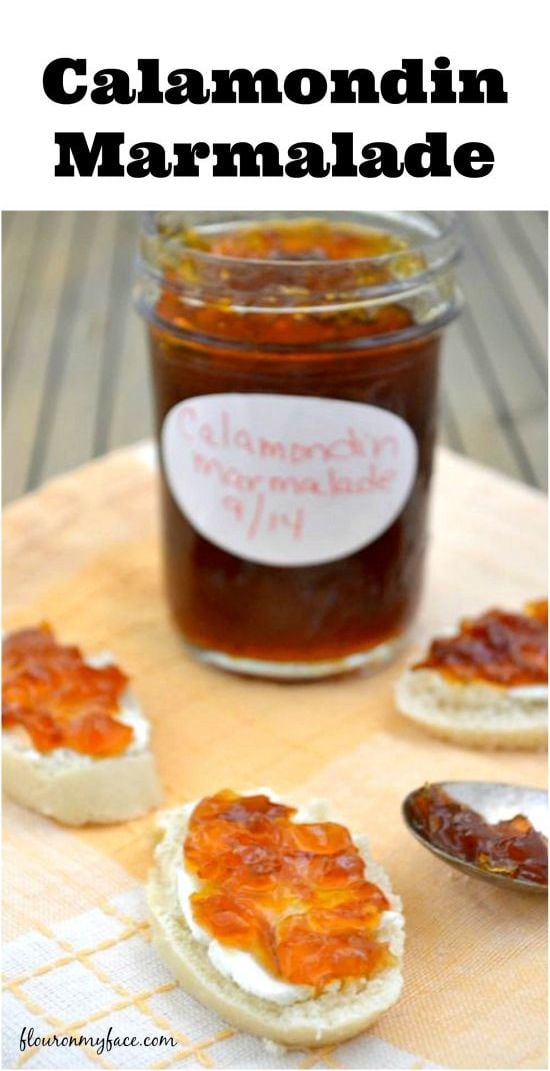
After I got home from Lowes I hit the internet running so I could find out all about these tiny little citrus gems called calamondin oranges.
What I found out was that they are so tender that the only way you can get your hands on them is pretty much to grow a calamondin tree yourself.
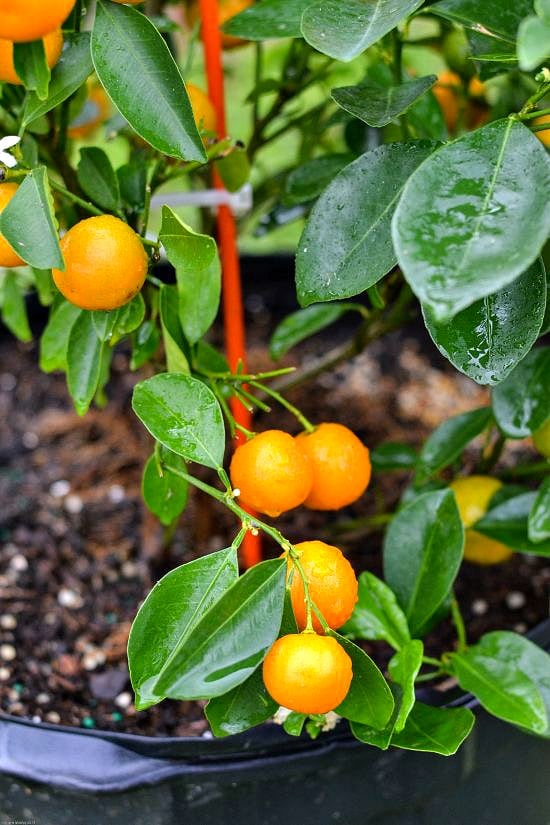
Growing a Calamondin Orange Tree
Have no fear though you can grow one yourself and if you don't live in Florida like I do or another warm climate state you can grow one in a container and bring it indoors during the winter months.
When the calamondin tree is in bloom your house will fill with the scent of orange flowers.
Right now my tree is in full bloom and when the wind blows just right and I am sitting on my lanai I can smell that sweet scent.
From what I read they are very easy to grow (here in Florida they bloom all year long) and if you plant one tree in the ground the seeds from the fruit that fall to the ground will sprout and before you know it you will have a calamondin grove growing.
I only have my one tree growing in a large pot right now but I may try growing a few more trees from seeds so I can share the calamondin love.
Calamondin Marmalade
If you just want to buy some calamondin marmalade or baked goods you can head over to the Calamondin Cafe.
They have a full line of products made with calamondin oranges.
They have a grove of calamondin oranges, make all their products by hand and are gmo-free, nut free and toxin free.
I also found them while I was researching the calamondin orange. You know what's funny? The Calamondin Cafe is a local business right here in my backyard.
They sell at some of our local farmer's markets so I had a chance to sample their calamondin marmalade when I saw their booth at my favorite farmers market.
If you're in the Southwest Florida area during the winter months be sure to check them out at the Lakes Park Farmers Market.
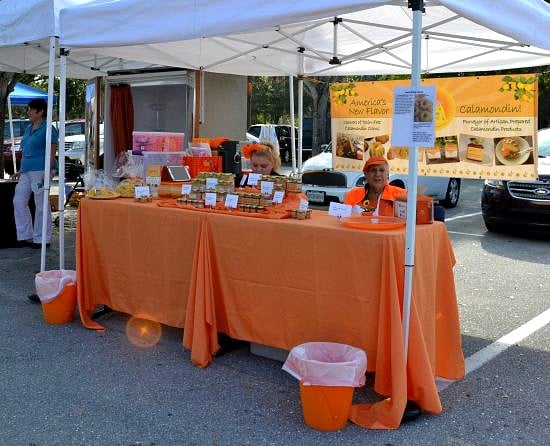
The Calamondin Cafe at the Lakes Park Farmers Market 2014-2015 season
How to make Calamondin Orange Marmalade
Canning marmalade is a bit different from canning other jams or jellies because the way you need to measure the ingredients is different to balance the unique texture and flavor of the peel that is used. Here's why:
Fruit and Peel: Marmalade uses whole citrus fruits, including the peel, which needs to be sliced thinly. The peel adds flavor and texture, so measuring it carefully ensures the right balance in the final product.
Water: Unlike most jams, marmalade requires adding water because citrus fruits are firmer and need extra liquid to soften during cooking. The amount of water is usually measured by volume (e.g., one cup of water per cup of fruit).
Sugar Ratio: The sugar is typically measured by the weight of the fruit, not by volume. This ensures the marmalade sets properly, as the sugar interacts with the natural pectin in the citrus to create the gel-like consistency.
Marmalade measurements focus more on the weight (for the sugar) and volume for the water because the combination of fruit, peel, and added water must balance perfectly for the right texture and flavor. This makes it a bit more precise than other jams or jellies.
Ingredients
The amount of calamondin oranges I am starting with is what I had on hand. Marmalade can be made with any amount of citrus fruit (but I wouldn't use less than 1 cup) because the important key is measuring the water and sugar correctly to match the amount of fruit you have started with.
By sticking to these measurements, you can make marmalade with any amount of citrus, whether you have a few fruits or a whole basketful!
- I'm using about 40 fresh calamondin sour oranges
- the juice and peel from the calamondin oranges
- equal amounts of water
- equal amounts of sugar
- 1 tablespoon butter
Simple Steps to Homemade Calamondin Marmalade
Making marmalade with calamondin oranges involves a few basic measurement steps to ensure the right balance of fruit, sugar, and liquid for the perfect consistency. Here's a general guideline:
Directions
Step 1: Slice and Seed: Squeeze the juice into a bowl and cut the calamondins peels into thin slices, removing and discarding the seeds.
Step 2: Measure the Fruit: Measure the sliced fruit and juice by volume (e.g., in cups). Note this volume for the water ratio.
Step 3: Add Water: For every cup of sliced calamondins and juice, add one cup of water. This step ensures the fruit cooks evenly and releases its natural pectin. (Example 1 ½ cups juice and peel means you will add 1 ½ cup water.)
Step 4: Measure the Sugar: Measure the sugar to equal the amount of fruit, peel and water (e.g., 1 ½ cups fruit, peel and water = 1 ½ cups of sugar). Less sugar may result in a thin set so do not try to make this recipe with less sugar.
Step 5: Cook the Mixture: Combine the fruit, water, and sugar in a large heavy bottomed pot. Make sure not to over fill the pot. The pot should only be about half way full to prevent boil overs. Heat on low to begin with, stirring occasionally so the sugar doesn't scorch on the bottom of the pot. Once the sugar has dissolved bring to a rolling boil, then reduce heat to a soft boil until the mixture reaches 220°F (104°C) on a candy thermometer, which is the setting point for marmalade.
Checking for a proper set
Test for Set: Place a saucer in the freezer before you begin. Use the "plate test". Check set by dropping a dollop of marmalade on the cold plate and push the edge with your fingertip. If marmalade wrinkles it has reached the proper set.
Hot Water Bath
- Follow all basic water bath canning safety measures for this recipe.
- Fill the jars to a ¼ inch head space. Wipe the rims with a damp paper towel. Place a flat lid on the jar and screw a band on finger tip tight.
- Process the marmalade in a hot water bath 20 minutes.
- Cool for 24 hours before cleaning the outside of the jars and storing.
- Label and date all jars.
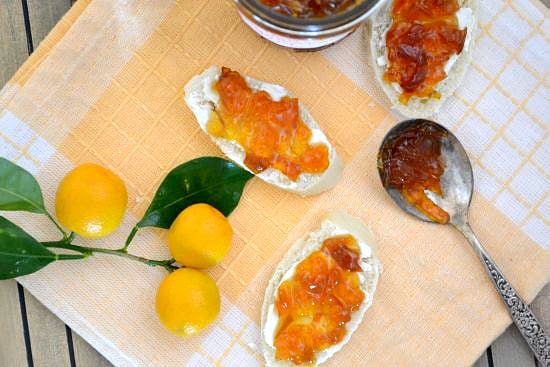
Tips
- Flattening each calamondin in half makes it very easy to thinly slice the peel into ribbons.
- Adding a tablespoon of butter to pot will help cut down on the foaming.
- Do not attempt to taste test the marmalade set right after making this marmalade recipe. Citrus based canning recipes like marmalade can take up to a month to set up properly. Hot, warm or freshly made marmalade will be thin right out of the canner. Place a jar in the refrigerator for 48 hours then see how thick it is.
- Proper set: If you properly measured the ingredients and cooked the marmalade to the proper gel setting temperature the marmalade will set up properly. Marmalade is not like other fruit jams and jellies.
The calamondin orange is a sour orange that is also perfect to make a Cuban mojo marinade.
Print the Calamondin Marmalade Recipe below.
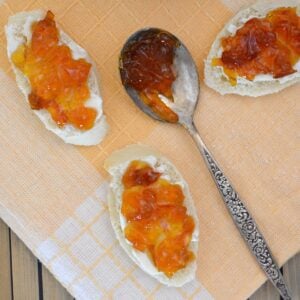
Calamondin Orange Marmalade
Ingredients
- 40 small fresh calamondin sour oranges
- equal amounts of sugar
- ¾ cup juice of the calamondin oranges (about ¾ cup)
- 1 ¼ cup water
- 1 tablespoon butter
Instructions
- Slice and Seed: Squeeze the juice into a bowl and cut the calamondins peels into thin slices, removing and discarding the seeds. Flatten each calamondin in half and thinly slice the peel into ribbons.
- Measure the Fruit: Measure the sliced peel and juice by volume (e.g., in cups). Pour into the pot. Note this volume for the water ratio.
- Add Water: For every cup of sliced calamondins peel and juice you have, add one cup of water. This step ensures the fruit cooks evenly and releases its natural pectin. (Example 1 ½ cups juice and peel means you will add 1 ½ cup water.) Add to the canning pot.
- Measure the Sugar: Measure the sugar to equal the amount of fruit, peel and water (e.g., 1 ½ cups fruit, peel and water = 1 ½ cups of sugar). Less sugar may result in a thin set so do not try to make this recipe with less sugar. Add the sugar to the pot.
- Add butter to pot.
- Cook the Mixture: You will have combined the fruit, water, and sugar in a large heavy bottomed pot. Make sure not to over fill the pot. The pot should only be about half way full to prevent boil overs. Heat on low to begin with, stirring occasionally so the sugar doesn't scorch on the bottom of the pot. Once the sugar has dissolved bring to a rolling boil, then reduce heat to a low boil until the mixture reaches 220°F (104°C) on a candy thermometer, which is the setting point for marmalade.
- Test for Set: Place a saucer in the freezer before you begin. Use the "plate test". Check set by dropping a dollop of marmalade on the cold plate and push the edge with your fingertip. If marmalade wrinkles it has reached the proper set.
- If the marmalade has not reach a proper set continue to cook checking for the set point every 10 minutes or so until reached.
Hot Water Bath
- Fill half pint canning jars with the marmalade, wipe the rims and place the flat lid on. Twist a metal band on the jar. just until finger tip tight. Repeat until all jars are filled.
- Process marmalade in a hot water bath for 20 minutes. Uncover the pot and turn off the heat. Wait 5 minutes before removing the jars from the canning pot. Place the hot jars on a towel to cool.
- Cool for 24 hours. Check to make sure all the jars have sealed before removing the metal bands and washing the jars off.
- Makes about 5 half-pint jars.
- Store the jars of marmalade in a cool dark cabinet.
Recipe Expert Tips
- Check the marmalade setting point: Place a glass saucer in the freezer while you are cooking the marmalade. To check to see if the marmalade has reach the marmalade setting point drop a small dollop of marmalade on the cold saucer. Allow the marmalade a couple of minutes to cool down. Use a finger tip to push the edge of the marmalade with your fingertip. If you can see the marmalade wrinkle it has reach the marmalade setting point.
- Adding a tablespoon of butter to pot will help cut down on the foaming.
- Do not attempt to taste test the marmalade for a proper set right after making this marmalade recipe. Citrus based canning recipes like marmalade can take up to a month to set up properly. Hot, warm or freshly made marmalade will be thin right out of the canner. Place a jar in the refrigerator for 48 hours then see how thick it is.
- Proper set: If you properly measured the ingredients and cooked the marmalade to the proper gel setting temperature the marmalade will set up properly. Marmalade is not like other fruit jams and jellies.


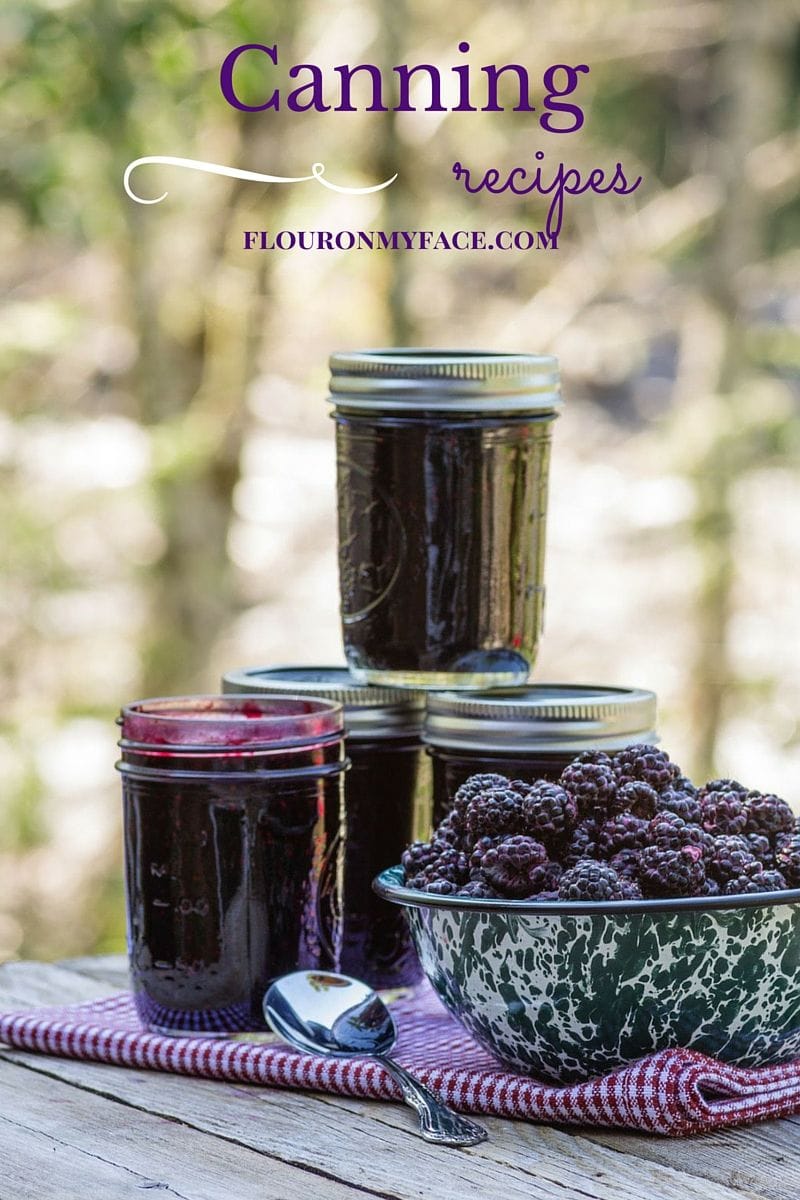

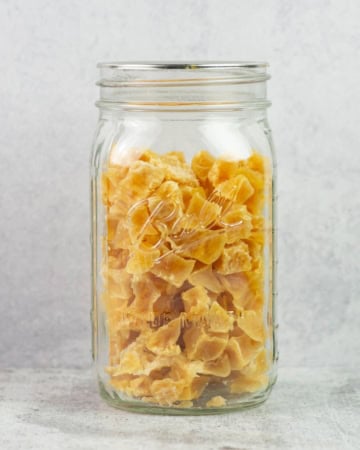
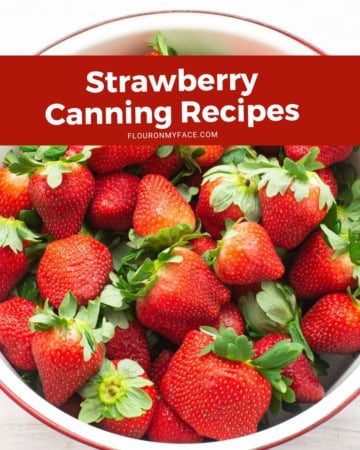
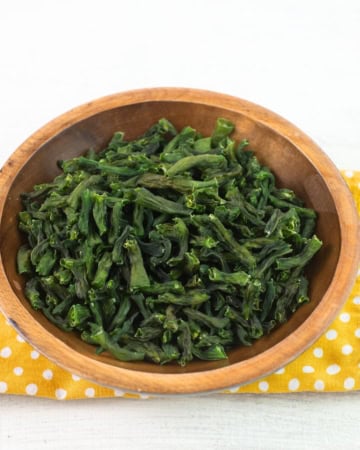
Lynn Butler
Loved this recipe very tasty and orangey. Will make again when my little calamondin tree grows some more friut.
Ronnie
I have made this marmalade three times, and my family and friends say it is the best marmalade ever. Thanks for your recipe.
Arlene Mobley
Ronnie Thank you for stopping by and letting me know how much you have enjoyed the recipe. It does have a delicious unique flavor from the calamondin oranges.
Angela
We must be neighbors! Lakes park is not too far from us… we just planted a calamondin tree (in the ground) and cannot wait to make this!
Thank you!
Arlene Mobley
Hello neighbor. I hope you enjoy the recipe. You can also use the juice of calamondin oranges to make Mojo marinade.
Deanna
My husband remembers his Grandmother sending Calamondin marmalade in the mail from Florida to NY in the 70's. It was such a a treat for him. Now, 46 years later, we harvested our Calamondins for the first time from 2 trees that were just tiny twigs sent to us in the mail from a seed company. It took 5 years for the one Calamondin tree to fruit. We're still waiting on the second to fruit. We keep them outside in the summers of East TN and bring them in for the winters. Thank you so much for this recipe. What a delight to share this family tradition with our children and now, grandchildren.
Dana
I was delighted to find this recipe. I have a calamond orange tree that is in a huge pot that’s lived with us in Maryland for over 20 years. The recipe came out perfectly and was pretty easy (once I figured out the equal amount of sugar part). Slicing the rinds and pulling out every seed is time consuming, but worth it. I will be making this again. It will make a great holiday gift with a loaf of homemade bread!
Arlene Mobley
Dana glad to hear you are enjoying the recipe!
Diana Smyth
Thank you for the great recipe. My first couple of batches didn't work, because I wasn't sure when I had hit the jelling point and I overdid it. The next two batches turned out perfect I just followed my other canning recipes which indicated once reached a full boil which wouldn't stop when stiring, cook for 1 minute and that was the ticket.
I have a couple of bushes and haven't done much with them in the past, but not this year. I made your marmalade recipe, calamondin liquor and a tart...all delicious.
If you have a calamonding pepper jam recipe I would love to see it.
Jeanne Beam
Why is butter added to the recipe?
Arlene Mobley
Butter is added to help cut down on the foaming as it boils. You can leave it out if you like.
Annie Schiller
This is my go-to recipe every time I make Calamondin Marmalade. We eat it all year and give it away to family every year and they love it! I keep getting requests for more. Thank you so much! Annie
Arlene Mobley
Annie so glad you are enjoying the recipe. My calamond tree is full of blooms. I can't wait to make another batch.
Pamela
Hi Arlene, thx for this recipe … I must be thick, I still don’t understand how much sugar to add.
i did read your reply to Veronica & Kate,
Could you clarify if the “equal amount of sugar” is equal to what?
- 1) Juice ie 3/4 cup of sugar in volume (not weight)
- 2) juice 3/4C + peel (let’s say 1/2C) = 1 1/4C sugar in volume (not weight)
- 3) juice + peel (eg 1 1/4C) + water (3/4C) to make 2 Cups ie 2 Cups of sugar in volume
- 4) juice + peel (total 3/4C) + water (1 1/4C) to make 2 Cups ie 2 Cups of sugar in volume
Or is it some other amounts?
Thx much!
Arlene Mobley
Hi Pamela sorry for the confusion! you get the equal amount of sugar by measuring the juice, peel and pulp if there is any. So if you have 2 cups (volume) of orange juice, pulp and peel then you would use 2 cups of sugar. Hope that helps!
Eleanor harkness
Can I double this recipe and when do I know when to pick the Calamondin?
Arlene Mobley
Eleanor yes you can double this marmalade recipe. You pick the Calamondin before they turn completely orange. You can still use the fruit if it is completely orange but they are consider over ripe at that point.
Jenny
I also am a great fan of calamondin marmalade. In fact once you have tasted it than all other marmalade pales by comparison. However, I think it is unnecessary to process the marmalade in a water bath. I have never done this with jams and jellies. It keeps well because of all the sugar.
Arlene Mobley
Hi Jenny
Calamondin Marmalade tastes amazing. But it is not safe to skip the hot water bath step when making jams and jellies. The hot water bath is to kill any bacteria that may be present in the jar.
Elizabeth
Made this today.... followed the recipe but it tasted bitter. Did more reading and found that even one small calamansi seed is in the pot it can turn the marmalade bitter. Also when cutting the fruit in half to juice it the seeds can also be cut up and fall into the juice causing it to become bitter.. be carefure when prepping!
Arlene Mobley
Elizabeth
Marmalades sometimes have a "bitter' flavor to them. Thanks for the tip about the seeds. Although I have not found this to be the case myself. Maybe next time you can be a little more careful and make sure you remove all the seeds from the juice before making the marmalade? You could easily pour it through a fine mesh strainer to remove all the seeds.
Patrick
You are definitely correct. Calamansi seeds are very bitter. Butting a seed in half can also make the juice bitter. A solution is to just cut the tip off of the fruit and squeeze out all the juice like a balloon
Veronica
What do you mean by equal amounts of sugar? Is it equal to the juice or the fruit or the water or any combination. This must be a silly question. Thanks
Arlene Mobley
Step 4: Measure the calamondin peel, water and calamondin juice before pouring into a large jam pot. Step 5: Measure equal amounts of sugar. Use the same amount of sugar that equals the measured ingredients in step 4.
Kate Jesse
I also have the question about how to measure the amounts of peel, water, and calamondin juice. Do you measure peel, water, and juice separately or together? How do you measure peel? If you have (example) 1/2 cup of peel, 1/2 cup of water, and 1/2 cup of juice would you measure out 1-1/2 cups of sugar? Your reply did not answer the question, you only repeated the same directions. If you would clarify this I would appreciate it.
Arlene Mobley
Hi Kate
Sorry if my instructions are confusing. Measure all the juice and peel of 40 calamondin oranges together. You can do this all together in a large measuring cup. Add enough water to bring the measurement up to equal 2 cups. Or you can juice and cut the peel from enough calamondin to equal 3/4 cups of peel and juice. The oranges you have may be larger or smaller than what I used. I needed 40 calamondin oranges to get 3/4 cups of juice and peel. I hope that helps.
Jane
What does it mean to "process marmalade in hot water bath for 20 miutes?
Arlene Mobley
Jane
You should follow safe canning practices by processing any canning recipe in a hot water bath or by pressure canning. Marmalade's are processed by hot water bath. Please see this documentation on how to hot water bath can before making this or any other canning recipe.
Margot
I really need to try this out!
Arlene Mobley
Margot
It is so good!
Andrea Pope
Is there a fruit comparable to the Calamondin? My grandmother lived in St. Petersburg FL and had a tree in her backyard. I can remember the marmalade and would love to make some. Do you have any suggestions? I live in Alabama and I don't think that I would be able to find a tree in this area or would it be able to survive our winters.
Arlene Mobley
Andrea
The only thing I can think of that would come close is a sour orange. Which is probably what was growing in your grandmothers yard. I'm not sure if you could find sour oranges either in Alabama. You can learn about them here All About Florida Oranges
Nicki RN
Is a kumquat what is considered a sour orange ? They are like little oranges and I always thought that is what marmalade was made from
Arlene Mobley
Hi Nicki
No a Kumquat is a different type of fruit. Marmalade is usually made from the fruit and zest of citrus fruit. A sour orange is just what it sounds like a very sour orange variety. You can't eat them like a navel orange because they are so sour. But they make a great marmalade because you use a lot of sugar when you are making marmalade. It cuts way back on the sour flavor of a sour orange. Sour oranges aren't available every where and the calamondin oranges are even more rare to find because you usually have to grow your own calamondin orange tree or be in an area where they grown and know someone who has a tree.
Nicki RN
Hi Arlene. A kumquat is a citrus, it is a little orange that has a sweet skin and sour flesh.
I looked on Google and found several recipes for orange marmelade using kumquats, was given a large bag of them by a friend so going to make some today
I also have a lemon tree and a Navel orange tree
Arlene Mobley
Hi Nicki although a kumquat is in the citrus family it is not the same as a little orange. Yes the kumquat can be used to make marmalade and jelly but the skin does not have a zest and it is very thin compared to the kumquat hybrid Calamondin Orange that I have used in this recipe.
You can eat the skin of the Kumquat and I am sure there are a few people who might eat the raw and uncooked skin of an orange, lemon, grapefruit or lime but it is not palatable compared to the kumquat.
I have never made marmalade or jelly with kumquats so I am not sure if you could switch out kumquats for calamondin oranges in this recipe since I am not sure of the difference in the amount of natural pectin that kumquats have compared to the calmondin oranges. If you use this recipe I would love to hear how it turns out.
Carol
I live in Mobile and have a Calamondia in a pot. We didn't even put it on the porch this winter since most nights were so mild. It's loaded now. Got it at the Botanical Garden Sale - a great source for unique plants that do well in your area.
Arlene Mobley
Carol
I hope Andrea sees your comment! I know I was excited when I found my Calamondin Tree. It's fun to grow uncommon citrus fruit trees if your area is warm enough. I have a Pondorosa lemon tree I hope gives me a bunch of huge lemons this year.
Louise
I live in South Alabama and these little trees grow all over the place in pots and the ground. They do have to be protected when the temperature gets too low which is not too often. Plant one in a large pot and I bet it will grow well for you. Good luck!
Arlene Mobley
Louise
I have read that they grow very easily from seed. I'll plant a few in a pot and see how well they grow for me here in my Florida garden.
Jon
We are growing a Calamondin in a Conservatory in Scotland, in the depths of winter we enclose it in small tent with a small heater to keep it above 5C. It seems to like our long summer days. Its been doing really well many fruit are starting to form, I hope for some marmalade this year 🙂
Arlene Mobley
Good luck Jon. My little Calamondin is in bloom right now. Can't wait to make more marmalade this year.
Linda
This sounds yummy! I can grow Meyer lemons in West Texas. Maybe I can find one of these trees. I made peach marmalade one time. I love it. But a peach pit got in the garbage disposer. My husband said he couldn't afford for me to save money by my making the marmalade and replacing a dispoerl. He just didn't understand my need to try new things! 🙂
Wishes for tasty dishes,
Linda
Arlene Mobley
Linda
If you can grow Meyer Lemons then you can probably grow calamondins. I found mine at Lowes last spring. Check there. Thanks for stopping by!